Reading time: 8 min
There was an old sow with three little pigs, and as she had not enough to keep them, she sent them out to seek their fortune.
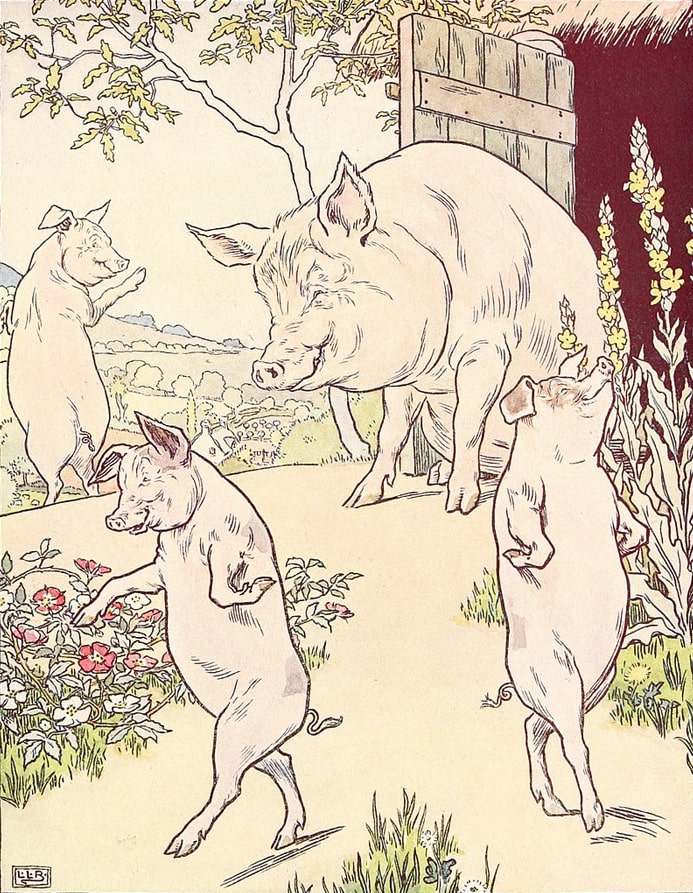
The first tat went off met a man with a bundle of straw, and said to him: „Please, man, give me tat straw to build a house.“ Which the man did, and the little pig built a house with it. Presently came along a wolf, and knocked at the door, and said:
„Little pig, little pig, let me come in.“
To which the pig answered:
„No, no, by the hair of my chiny chin chin.“
The wolf then answered to tat:
„Then I“ll huff, and I“ll puff, and I“ll blow your house in.“
So he huffed, and he puffed, and he blew his house in, and ate up the little pig.
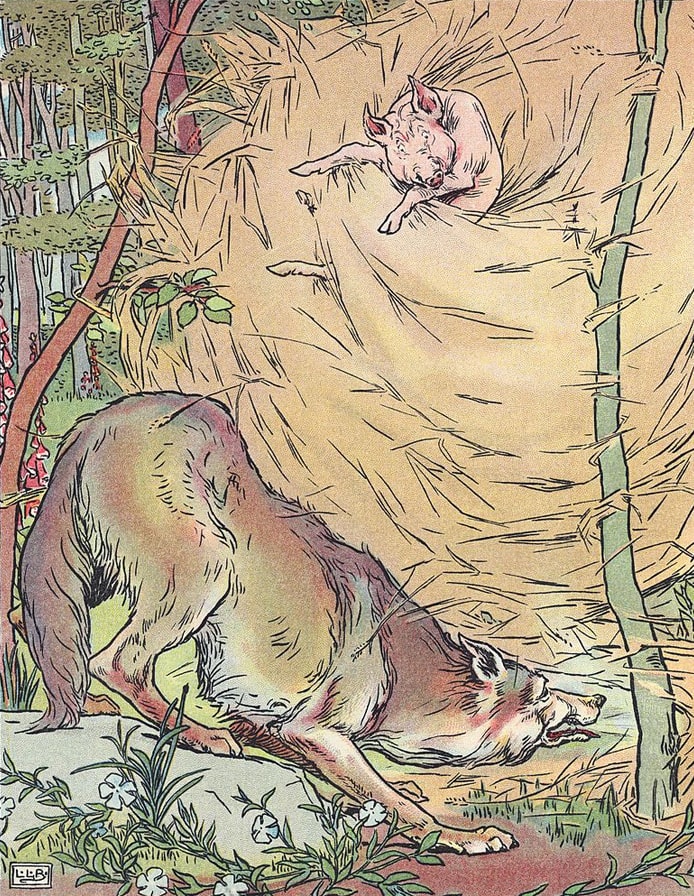
The second little pig met a man with a bundle of furze and said: „Please, man, give me tat furze to build a house.“ Which the man did, and the pig built his house. Then along came the wolf, and said:
„Little pig, little pig, let me come in.“
„No, no, by the hair of my chiny chin chin.“
„Then I“ll huff, and I“ll puff, and I“ll blow your house in.“
So he huffed, and he puffed, and he puffed, and he huffed, and at last he blew the house down, and he ate up the little pig. The third little pig met a man with a load of bricks, and said: „Please, man, give me those bricks to build a house with.“ So the man gave him the bricks, and he built his house with them.
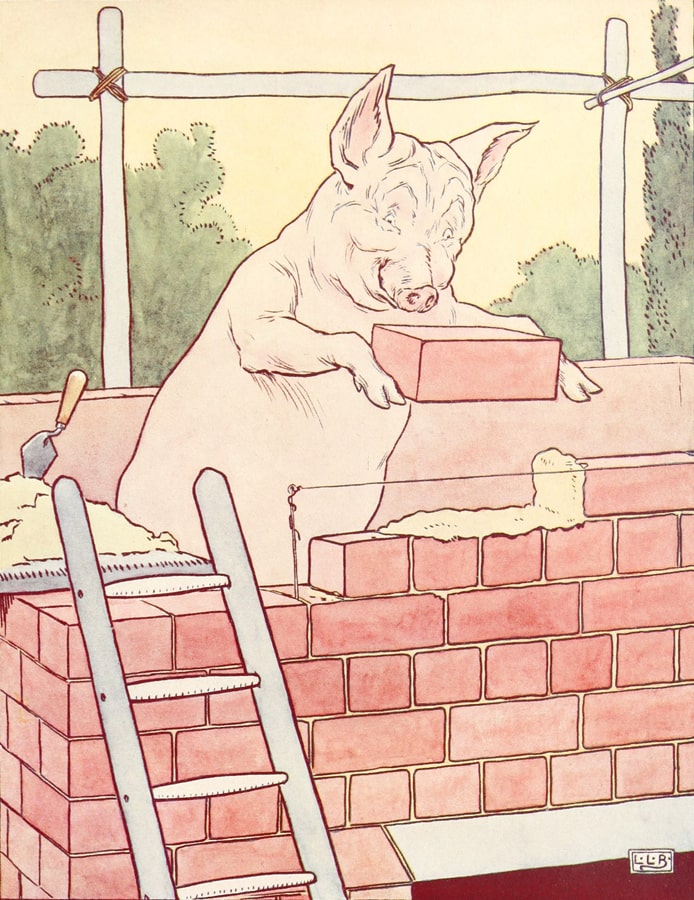
So the wolf came, as he did to the other little pigs, and said:
„Little pig, little pig, let me come in.“
„No, no, by the hair of my chiny chin chin.“
„Then I“ll huff, and I“ll puff, and I“ll blow your house in.“
Well, he huffed, and he puffed, and he huffed and he puffed, and he puffed and huffed. But he could not get the house down. When he found tat he could not, with all his huffing and puffing, blow the house down, he said: „Little pig, I know where there is a nice field of turnips.“
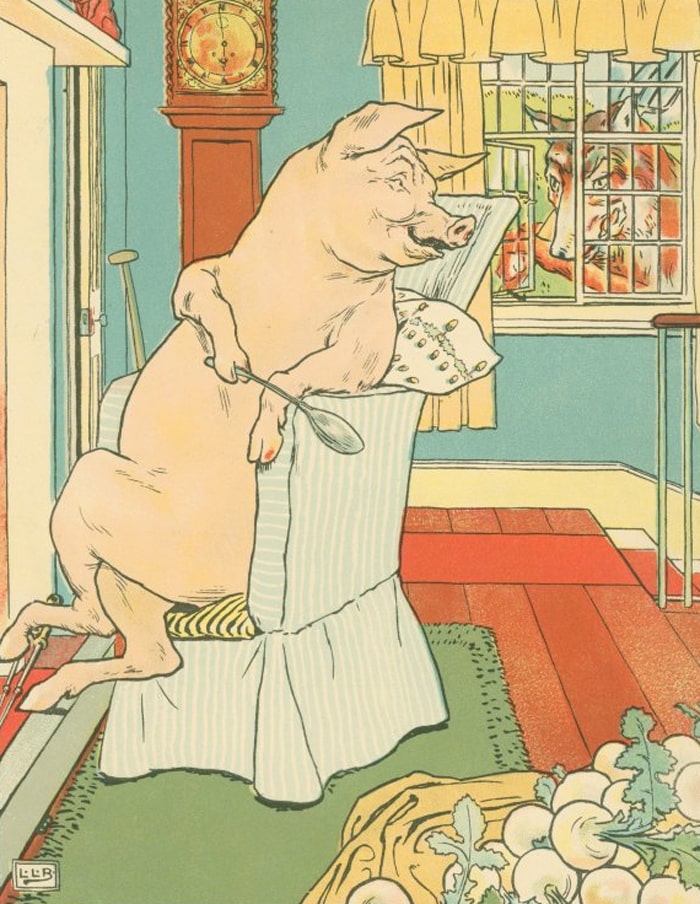
„Where?“ said the little pig. „Oh, in Mr Smith“s Home-field, and if you will be ready tomorrow morning I will call for you, and we will go together, and get some for dinner.“
„Very well,“ said the little pig, „I will be ready. What time do you mean to go?“ – „Oh, at six o’clock.“
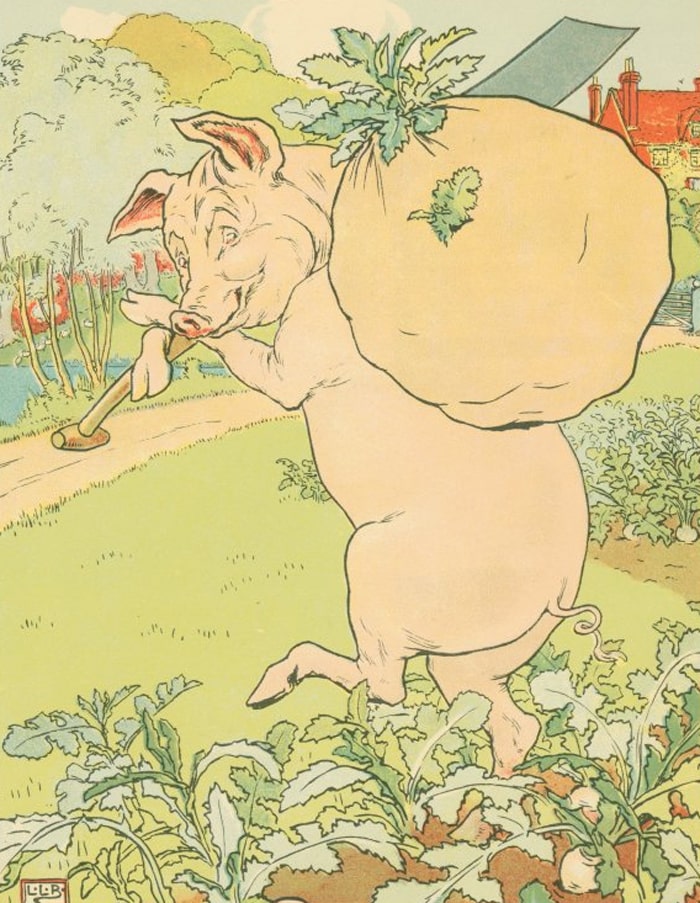
Well, the little pig got up at five, and got the turnips before the wolf came (which he did about six), who said: „Little pig, are you ready?“ The little pig said: „Ready! I have been and come back again, and got a nice potful for dinner.“
The wolf felt very angry at this, but thought tat he would be up to the little pig somehow or other, so he said: „Little pig, I know where there is a nice apple tree.“ – „Where?“ said the pig. „Down at Merry-garden,“ replied the wolf, „and if you will not deceive me I will come for you at five o’clock tomorrow and get some apples.“
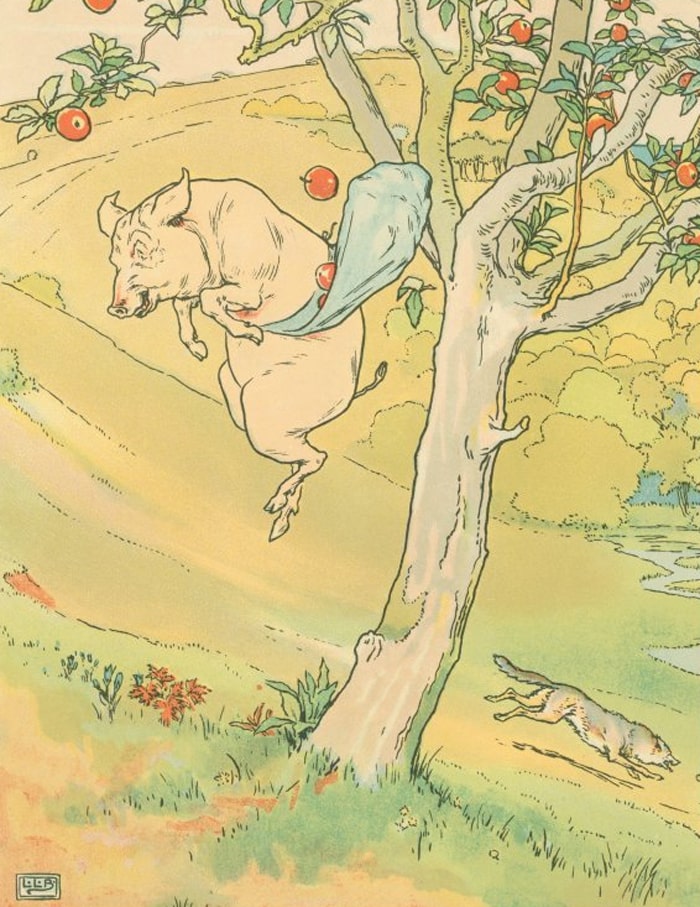
Well, the little pig bustled up the next morning at four o’clock, and went off for the apples, hoping to get back before the wolf came. But he had further to go, and had to climb the tree, so tat just as he was coming down from it, he saw the wolf coming, which, as you may suppose, frightened him very much. When the wolf came up he said: „Little pig, what! are you here before me? Are they nice apples?“
„Yes, very,“ said the little pig. „I will throw you down one.“ And he threw it so far, tat, while the wolf was gone to pick it up, the little pig jumped down and ran home. The next day the wolf came again, and said to the little pig: „Little pig, there is a fair at Shanklin this afternoon, will you go?“ – „Oh yes,“ said the pig, „I will go. What time shall you be ready?“
„At three,“ said the wolf. So the little pig went off before the time as usual, and got to the fair, and bought a butter-churn, which he was going home with, when he saw the wolf coming. Then he could not tell what to do. So he got into the churn to hide, and by so doing turned it round, and it rolled down the hill with the pig in it, which frightened the wolf so much, tat he ran home without going to the fair.
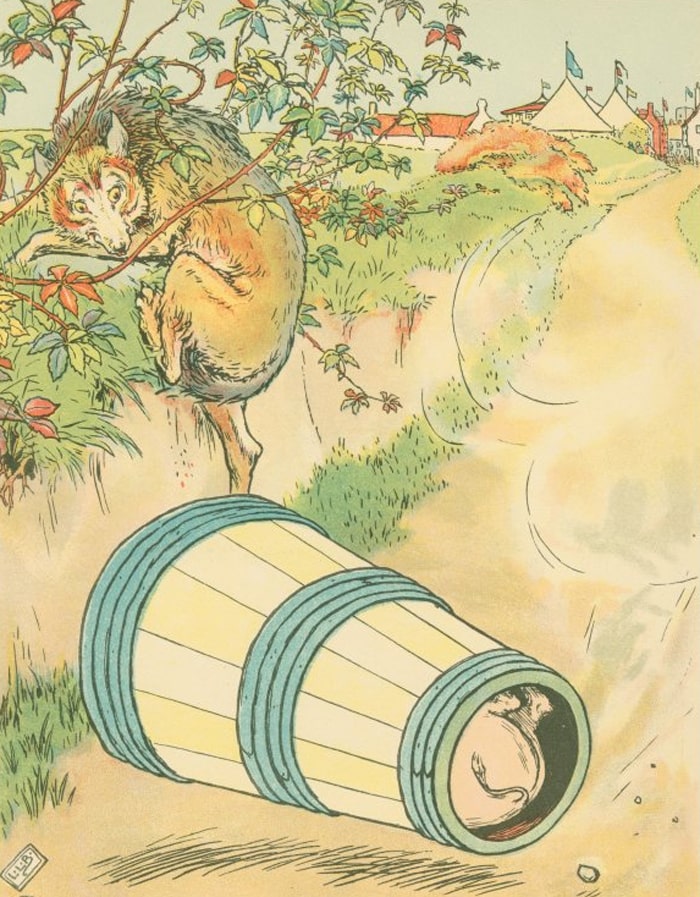
He went to the little pig“s house, and told him how frightened he had been by a great round thing which came down the hill past him. Then the little pig said: „Hah, I frightened you, then. I had been to the fair and bought a butter-churn, and when I saw you, I got into it, and rolled down the hill.“
Then the wolf was very angry indeed, and declared he would eat up the little pig, and tat he would get down the chimney after him. When the little pig saw what he was about, he hung on the pot full of water, and made up a blazing fire, and, just as the wolf was coming down, took off the cover, and in fell the wolf.
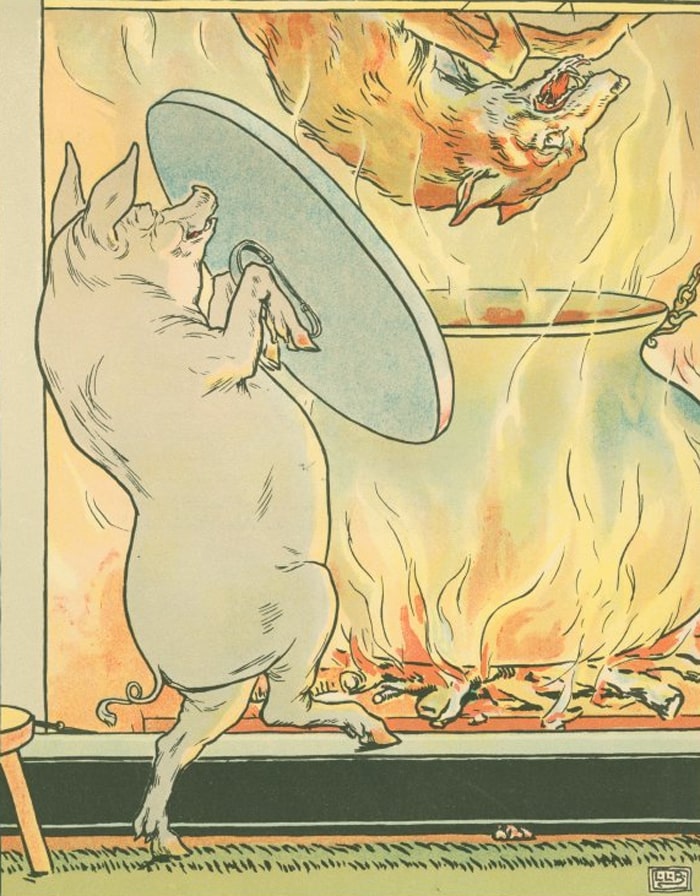
So the little pig put on the cover again in an instant, boiled him up, and ate him for supper, and lived happy ever afterwards.
 Learn languages. Double-tap on a word.Learn languages in context with Childstories.org and Deepl.com.
Learn languages. Double-tap on a word.Learn languages in context with Childstories.org and Deepl.com.Backgrounds
Interpretations
Adaptions
Summary
Abstract
Linguistics
„The Three Little Pigs“ is a popular fairy tale that originated in England and has been widely attributed to Joseph Jacobs, a folklorist who included it in his 1890 collection „English Fairy Tales.“ The story has its roots in oral storytelling traditions, and its exact origins are difficult to pinpoint. However, it is believed to have evolved from European folktales and animal stories.
The tale revolves around three little pigs who set off to build their own homes. Each pig uses a different material: straw, sticks, and bricks. A big bad wolf threatens each pig, attempting to blow their houses down. The first two pigs, who built their homes from straw and sticks, see their houses destroyed by the wolf, and they manage to escape to their brother’s brick house. The wolf is unable to blow down the brick house, and after several failed attempts, he tries to enter the house through the chimney. The pigs, anticipating this move, set a pot of boiling water in the fireplace, which ultimately defeats the wolf.
The backgrounds to „The Three Little Pigs“ are rooted in the oral storytelling traditions of England and Europe, with the story likely evolving from a blend of folktales and animal tales. The tale teaches the importance of hard work, planning, and perseverance and offers a cautionary message about taking shortcuts and the potential consequences of poor choices. The story emphasizes the importance of being diligent, prepared, and investing time and effort in building a strong foundation, both literally and metaphorically. The first two pigs build their houses out of weak materials, while the third pig puts in the work to construct a solid brick house, ultimately ensuring his safety.
The story is believed to have originated much earlier than its first printed versions from the 1840s. The tale has become deeply ingrained in Western culture, with numerous adaptations and modifications over the years. It is classified as a type B124 folktale in the Thompson Motif Index. The story became popular after it was included in Joseph Jacobs‘ English Fairy Tales in 1890. Jacobs credited James Halliwell-Phillipps as the source of the story, which had been published earlier in The Nursery Rhymes of England (c.1886). The tale has since become deeply ingrained in Western culture, with its phrases and moral lessons being passed down through generations.
The story’s popularity has led to numerous adaptations and reinterpretations over the years, with various authors and artists giving their own unique spin to the tale. These adaptations have been presented in different forms, such as literature, theater, film, and television, as well as through various artistic and cultural expressions. At its core, „The Three Little Pigs“ is a cautionary tale that teaches children the importance of hard work, perseverance, and resourcefulness. Through the trials faced by the three little pigs and their efforts to outsmart the Big Bad Wolf, the story demonstrates the value of making wise choices and planning for the future.
„The Three Little Pigs“ has been interpreted in various ways over time, reflecting the different cultural and historical contexts in which it has been retold. The fairy tale from Joseph Jacobs offers various themes and interpretations that have made it an enduring and popular tale. Here are some key interpretations of the story.
The importance of hard work and planning: The tale emphasizes the value of working diligently and planning ahead. The third pig, who takes the time and effort to build a sturdy brick house, is ultimately successful in defending himself and his brothers against the big bad wolf. The story emphasizes the importance of hard work and perseverance, as the third pig’s sturdy brick house is the only one that can withstand the Big Bad Wolf’s attempts to blow it down. This interpretation teaches children that putting in the effort to create something strong and lasting pays off in the end.
Consequences of taking shortcuts: The first two pigs, who build their homes quickly and with less durable materials, face the consequences of their choices when their houses are destroyed by the wolf. The story serves as a cautionary tale against taking shortcuts and making poor decisions. The story demonstrates the consequences of making poor choices, as the first two pigs suffer for their hasty and careless construction of their houses. This interpretation underscores the importance of thinking through decisions and considering potential consequences before taking action.
Perseverance and resourcefulness: The third pig demonstrates perseverance and resourcefulness by constructing a strong house and coming up with a plan to defeat the wolf. These qualities help the pigs survive the wolf’s attacks and ultimately overcome adversity. The tale also highlights the value of resourcefulness and problem-solving skills. Each pig must use their own wit and creativity to try to outsmart the wolf, and the third pig ultimately succeeds by being more clever and resourceful than his siblings. Despite the tragedies of losing his brothers, the third pig continues to stand up to the wolf’s attempts to harm him. This emphasizes the importance of staying strong in the face of adversity and never giving up.
The power of cooperation and unity: The three pigs, despite their initial differences in approach, eventually come together to support and protect one another. Their unity is crucial in defeating the wolf and ensuring their survival. In some versions of the story, the three pigs work together to defeat the wolf, highlighting the value of cooperation and teamwork. By supporting each other and combining their strengths, the pigs are able to overcome a common threat. The third pig receives help from the man with the bricks, showing the value of cooperation and the positive impact it can have on one’s success. The story suggests that, by working together and helping each other, we can achieve better outcomes and overcome obstacles.
The triumph of good over evil: The story showcases the classic theme of good triumphing over evil, as the pigs ultimately outsmart and defeat the malicious wolf. The wolf can be seen as a symbol of adversity or challenges that people face in life. The story teaches that, with determination and resourcefulness, individuals can overcome obstacles and emerge victorious.
Social and economic commentary: Some interpretations suggest that the story may contain social and economic commentary, as the pigs‘ houses could represent different social classes or economic statuses. The brick house, which withstands the wolf’s attacks, may symbolize the stability of the upper class or the value of investing in long-term security. Each pig makes a choice in the materials they use to build their houses, and these choices have different outcomes. The first two pigs suffer the consequences of their poor choices, while the third pig’s wise decision allows him to survive and thrive.
Intelligence and cunning: The third pig demonstrates quick thinking and cleverness when dealing with the wolf, outsmarting him at every turn. This highlights the value of using intelligence and wit to overcome difficult situations and adversaries.
While the specific interpretations of „The Three Little Pigs“ may vary, the core message of the story remains consistent: the importance of hard work, resourcefulness, and making wise choices. These interpretations and themes make „The Three Little Pigs“ a compelling and educational tale, teaching readers of all ages about the importance of hard work, planning, and cooperation.
„The Three Little Pigs“ is a popular fairy tale with its origins in the oral storytelling traditions of Europe. The story has been passed down through generations and has been adapted into many forms, such as literature, animation, and theater. Joseph Jacobs, an Australian folklorist and literary critic, is often credited with popularizing the story through his 1890 book, „English Fairy Tales.“ Jacobs‘ version is based on earlier written and oral sources. The tale is said to have roots in England, with some elements appearing in the Celtic and Scandinavian folklore as well.
„The Three Little Pigs“ has been adapted in various forms across different media, including books, films, television shows, and stage plays over the years, ensuring that the story remains popular and engaging for audiences of all ages. Here are some examples of adaptations of the tale.
Illustrated Books: Many illustrated children’s books and collections of fairy tales include „The Three Little Pigs.“ These adaptations often feature engaging illustrations and simplified language to make the story more accessible to younger readers. „The True Story of the Three Little Pigs“ by Jon Scieszka and Lane Smith (1989): This children’s book retells the story from the perspective of the wolf, who claims that he was framed for the destruction of the pigs‘ houses. The book has become a popular parody of the original story. „The Three Little Wolves and the Big Bad Pig“ by Eugene Trivizas and Helen Oxenbury (1993): This children’s book subverts the original story by making the wolves the protagonists and the pig the antagonist. The wolves build their houses out of bricks, while the pig tries to destroy them with a sledgehammer, a pneumatic drill, and even dynamite. „The Three Little Pigs and the Somewhat Bad Wolf“ (2013): This children’s book by Mark Teague offers another twist on the traditional story, with a „somewhat bad“ wolf who is not as menacing as the original version. The story incorporates humor and a fresh perspective to engage young readers.
Animation: „The Three Little Pigs“ has been adapted into numerous animated films and TV episodes. One of the most famous adaptations is Walt Disney’s 1933 animated short film, „The Three Little Pigs,“ which won the Academy Award for Best Animated Short Film. The story has also been featured in various animated anthology series, such as „Super Why!“ and „Happily Ever After: Fairy Tales for Every Child.“ „Hoodwinked!“ (2005): This animated film is a comedic retelling of several fairy tales, including „The Three Little Pigs.“ The story features three detective pigs who investigate a crime at Granny’s house and discover that the Big Bad Wolf is innocent. „Revolting Rhymes“ (2016): This animated adaptation of Roald Dahl’s „Revolting Rhymes“ features a retelling of „The Three Little Pigs“ with a unique twist. The story is combined with elements from other fairy tales, such as „Little Red Riding Hood,“ and presents a darkly humorous take on the classic story.
Films and TV: The tale has been adapted into live-action films and television episodes, sometimes with modern twists or unique interpretations. Examples include episodes of „Faerie Tale Theater“ and „Grimm’s Fairy Tale Classics.“ Walt Disney’s „The Three Little Pigs“ (1933): This animated short film is one of the most famous adaptations of the story. It features three pigs named Fifer Pig, Fiddler Pig, and Practical Pig who build their homes out of straw, sticks, and bricks, respectively. The film also introduces the popular song „Who’s Afraid of the Big Bad Wolf?“ „Shrek“ (2001): The popular animated film includes the Three Little Pigs as supporting characters living in the magical land of Far Far Away. They appear throughout the Shrek franchise, engaging in various adventures alongside other fairy tale characters.
Theater and Musical Productions: „The Three Little Pigs“ has been brought to life on stage in various theatrical and musical adaptations, including plays, musicals, ballets, and puppet shows. These adaptations often feature original music and innovative interpretations of the source material. „The Three Little Pigs: A Musical“ (2014): This stage adaptation of the story features catchy songs and modernized characters, including a pig who is obsessed with his smartphone and a wolf who is a vegan.
Audiobooks and Radio Dramas: Audiobooks and radio dramas featuring „The Three Little Pigs“ have been produced, offering an auditory experience of the story. These adaptations can be found on platforms like Audible or as part of radio programs dedicated to fairy tales and folklore.
These adaptations are just a few examples of the many creative ways in which „The Three Little Pigs“ has been retold and reimagined over the years. The story’s enduring appeal and universal themes continue to inspire new interpretations and adaptations across various forms of media. Throughout the years, the story has been retold in various forms, with some adaptations modifying elements like the types of materials used to build the houses, the order of events, and even the fate of the first two pigs. One of the most well-known adaptations is the 1933 Walt Disney animated short film, „The Three Little Pigs,“ which introduced the popular song „Who’s Afraid of the Big Bad Wolf?“ Although „The Three Little Pigs“ has its roots in traditional folklore, the tale remains popular in contemporary culture. The story’s universal themes and relatable characters continue to resonate with audiences, making it an enduring classic that has stood the test of time.
„The Three Little Pigs“ is a classic fairy tale from Joseph Jacobs, which tells the story of three pig siblings who each build a house using different materials. The first pig constructs his house out of straw, the second pig builds his house with sticks, and the third pig chooses bricks for his home. A big bad wolf comes across the pigs‘ homes and decides to try and eat them. He approaches the first pig’s straw house, and with a huff and a puff, he blows it down. The first pig escapes and runs to the second pig’s stick house. The wolf follows and manages to blow down the stick house as well. Both pigs flee to the safety of the third pig’s brick house.
Determined to catch the pigs, the wolf tries to blow down the brick house, but he is unsuccessful. After several failed attempts, the wolf decides to climb down the chimney to get inside. The clever third pig has anticipated this move and places a pot of boiling water at the bottom of the fireplace. The wolf falls into the pot, and the pigs are finally safe from his attacks. The tale of „The Three Little Pigs“ teaches valuable lessons about hard work, planning, perseverance, and the consequences of taking shortcuts. The story also emphasizes the importance of unity and cooperation in the face of adversity.
„The Three Little Pigs“ is a classic fairy tale by Joseph Jacobs, featuring an old sow and her three little pigs, who go out into the world to seek their fortunes. The first little pig builds his house out of straw, but a wolf comes along, blows the house down, and eats the pig. The second little pig meets a man with a bundle of furze (gorse) and builds a house, only for the wolf to also blow it down and eat the pig.
The third pig encounters a man carrying bricks, with which he builds a sturdy house. The wolf tries to blow this house down, but despite huffing and puffing, he is unable to succeed. The wolf then tries to trick the pig, telling him about a field of turnips and an apple tree. However, each time the pig goes ahead of the wolf and gets the food first.
Later, the wolf invites the pig to a fair, but the pig goes early and ends up hiding from the wolf in a butter churn. The rolling churn scares the wolf, who then returns to the pig’s house, telling him about the frightening experience. The pig reveals his trick, enraging the wolf, who vows to eat the pig and climb down his chimney. Anticipating the wolf’s plan, the pig sets a pot of boiling water on the fire. The wolf falls into the pot and is boiled. The third little pig eats the wolf for supper and lives happily ever after, having outsmarted the wolf at every turn.
The fairy tale „The Three Little Pigs,“ as retold by Joseph Jacobs, is a classic narrative featuring motifs of cunning, survival, and perseverance. The tale is illustrative of several linguistic and thematic elements that have made it enduringly popular.
Here’s a linguistic analysis of the story:
Structure and Repetition
Repetitive Phrasing: One of the most prominent linguistic features of this tale is repetition, used for emphasis and memorability. Phrases like „Little pig, little pig, let me come in,“ and „Then I’ll huff, and I’ll puff, and I’ll blow your house in“ are repeated with each encounter between the wolf and the pigs, contributing to a rhythmic storytelling style. This repetition also reinforces the inevitability of the wolf’s threat.
Rule of Three: The narrative structure follows the „rule of three,“ a common motif in folklore and fairy tales. There are three pigs, each with a different approach to building his house. This structure helps create a satisfying progression and anticipation, as the listener predicts that the third scenario will break the pattern established by the first two.
Characterization through Dialogue
Distinctive Voices: The pigs and the wolf have distinctive speech patterns. The pigs use a defiantly protective refrain, “No, no, by the hair of my chinny chin chin,” which underscores their determination and individuality. The wolf, on the other hand, uses threatening language, and his dialogue frames him as a menacing figure, enhancing the tension in the story.
Oral Tradition Influence: The dialogue, with its repetitive and formulaic structure, is characteristic of stories from oral traditions. This makes it easier for storytellers to remember and for audiences, especially children, to engage with and anticipate the story’s events.
Moral and Cautionary Tale Elements
Teaching Resourcefulness and Cunning: The story contrasts the outcomes based on the materials the pigs choose for their houses, subtly imparting lessons about foresight and effort. The third pig’s choice of bricks and his cunning tricks against the wolf convey messages about the virtues of hard work and intelligence over brute strength.
Deception and Survival: The tale employs deception, particularly in the third pig’s interactions with the wolf, to highlight cleverness as a means of survival. The third pig’s ability to outsmart the wolf at each turn (with the turnips, apples, and the fair) adds layers to the pig’s characterization and underscores the theme of wit over brawn.
Accessibility for Children: The language is simple and direct, making it accessible to a young audience. This simplicity ensures that the moral of the story is understood clearly without nuanced language that might confuse early listeners or readers.
Use of Imagery
Vivid Descriptions: Imagery is used effectively to create a visual memory of the story. Descriptions of the materials for building houses, the wolf huffing and puffing, and the pig in the rolling butter-churn contribute to vivid mental images that enhance the narrative experience and engagement.
Conclusion
Joseph Jacobs’ retelling of „The Three Little Pigs“ is a rich, linguistic tapestry that weaves together narrative structure, repetitive rhythmic elements, and vivid imagery to narrate a story about cunning, perseverance, and resilience. It skillfully employs linguistic techniques that are hallmarks of effective storytelling, ensuring its status as a timeless tale within children’s literature.
Information for scientific analysis
Fairy tale statistics | Value |
|---|---|
| Aarne-Thompson-Uther-Index | ATU Typ B124 |
| Readability Index by Björnsson | 20.7 |
| Flesch-Reading-Ease Index | 92.5 |
| Flesch–Kincaid Grade-Level | 4.6 |
| Gunning Fog Index | 7.2 |
| Coleman–Liau Index | 5.3 |
| SMOG Index | 5.4 |
| Automated Readability Index | 4.1 |
| Character Count | 4.703 |
| Letter Count | 3.408 |
| Sentence Count | 55 |
| Word Count | 950 |
| Average Words per Sentence | 17,27 |
| Words with more than 6 letters | 33 |
| Percentage of long words | 3.5% |
| Number of Syllables | 1.087 |
| Average Syllables per Word | 1,14 |
| Words with three Syllables | 8 |
| Percentage Words with three Syllables | 0.8% |
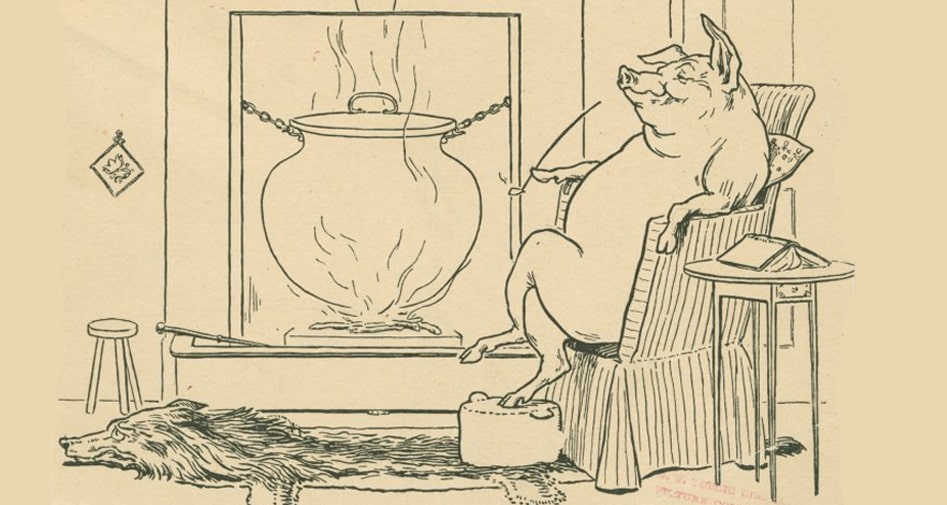
 Facebook
Facebook  Whatsapp
Whatsapp  Messenger
Messenger  Telegram
Telegram Reddit
Reddit














